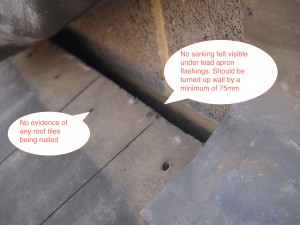I carried out another detailed inspection of a new build property in Northamptonshire today and was immediately alarmed at the poor finishing seen to the stepped lead and apron flashings on the front elevation. Coincidentally, the brickwork was the worst I’ve ever seen on a new build property but that will be the subject of another blog. I am consistently finding that developers do not seem to understand the technical requirements when it comes to installing leadwork and I always advocate the need to investigate the quality of lead installation beyond surface appearances; particularly when surface appearances are as bad as seen in our first image.

Lead should be turned into the bed joint a a minimum of 25mm and should be securely lead pegged at 450mm centres. Once pegged the bed joint can be pointed up or sealed with a proprietary lead sealant. Lead has an incredibly high coefficient of expansion, which is why it should not exceed lengths of 1.5m when installed, this is all about limiting or managing the level of differential expansion at junction details. Failure to allow for differential expansion is a primary cause of lead flashing failure. This particular apron flashing was installed to the garage entrance porch so was accessible for closer inspection from a ladder. Lifting the apron revealed an easy route into the building for wind driven rain and NHBC guidance had not been followed with regard to extending the sarking membrane and turning it up the wall underneath the apron flashings. The NHBC recently released a technical bulletin that included a reference to this common defect, it is one they are consistently finding and my experience of this problem mirrors theirs. So even if the apron flashings were correctly installed there is no secondary barrier to prevent issues with wind driven rain.
The keen eyed amongst you may have noticed that a lead securing wedge is visible to the left hand side of the bed joint in the first image. Whilst this inspires some hope that the lead has been securely wedged this hope is offset by virtue of the fact that the wedge is visible. A correctly installed lead peg or wedge should not be visible and if it is then the weather resistance of the bed joint is compromised in that area.
When suspicions are raised to the degree they were raised on this inspection then there is a strong argument for gently tugging the corner of the lead. Correctly installed lead will not move whereas poorly installed lead will tend to do this…

There was 5mm of lead turned into the bed joint as opposed to the required 25mm and lead wedges were installed but not providing a tight interference fit to secure the lead. In fact the only thing holding the 5mm of lead in place was a bead of grey mastic and this lead apron was always destined for very early failure. On the upside, the installer had managed to overlap sections of lead by the minimum required 100mm but there was very little else to redeem this installation.
The lead aprons to the garage porch were further susceptible to wind driven rain because there had been a complete failure to clip the free edge of the lead at 450mm centres; this would prevent wind from lifting the lead and therefore increasing vulnerability to rain.

Moreover, the lead apron flashings were further susceptible to wind driven rain since the roofer had failed to comply with NHBC requirements relating to the need to overlap sarking membrane and turn it up the wall by the minimum required 75mm.

Incidentally, I also measured the lead thickness with a micrometer to ensure that code 4 lead was installed and it was the required 1.8mm; it is not unusual for me to find that cheaper code 3 lead has been installed.
It worries me that the plumbers art of installing lead to a high standard is becoming lost but in this particular case the lead installations were as simple as it gets. You can make up your own mind as to whether this is poor quality workmanship, complete ignorance of the guidelines relating to lead flashing installation or a combination of both problems.
Joe Malone BSc(Hons) MCIOB MCABE

Leave a Reply